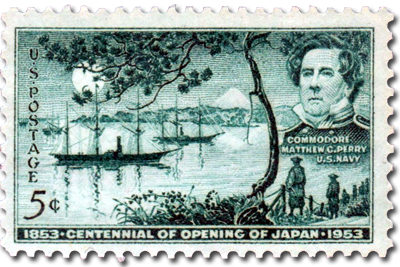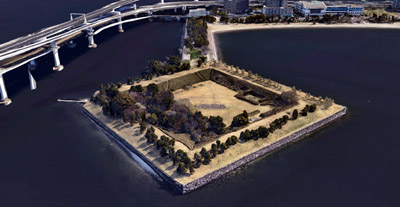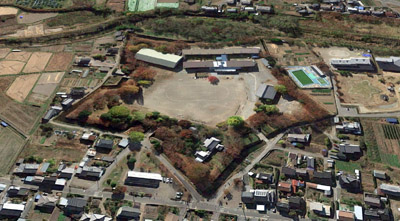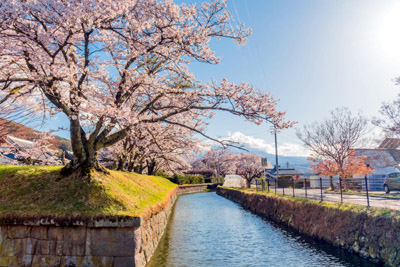 |
Tatsuoka Castle
Taguchi Saku City, Nagano, Japan
|
|
 |
Constructed: 1863-1867
Used by: Japan
Conflicts in which it participated:
None
|
I do realize that it's a bit insulting to begin the story of a fortification in Japan when the Western Europeans showed up. Japanese culture had been rolling along quite nicely (and violently) for a thousand years prior to 1543, when the Portuguese kurofine (Black Ships) appeared at Nagasaki, initiating a trade route with their colony at Goa, on India's west coast...but this website is about starforts, starforts are a Western European invention, and it was Western European influence that spawned starforts elsewhere in the world. My cultural apologies.
The Portuguese and Japanese conducted trade for almost a century, though the westerners were only permitted to land and operate at Nagasaki. Surely the Portuguese would have loved to build a starfort there as was their wont, but the Japanese were having none of that nonsense. |
 |
|
|
Complicating things was of course Christianity, which was, as ever, introduced to whomsoever of the local populace that might listen. The Shimabara Rebellion, following a drastic raise of taxes in the Nagasaki region but also a protest against religious persecution of local Catholics, raged from December of 1637 to April of 1638. Once this insurrection had been suppressed, the Tokugawa Shogunate, which ruled Japan from 1600 'til 1868, blamed Christian influence and expelled the Portuguese and Dutch traders, who were also doing business at Nagasaki. What followed was a century of the "locked state," in which any foreigners who approached Japan's shores were repelled with the profligate application of pointy things.
|
 A 1953 US postal stamp celebrating the centennial of Perry's Opening of Japan. Think Japan released a similar stamp in 1953? I don't think so either. A 1953 US postal stamp celebrating the centennial of Perry's Opening of Japan. Think Japan released a similar stamp in 1953? I don't think so either. |
 |
A man who would not be deterred by pointy things regardless of how they were applied was Commodore Matthew Perry (1794-1858). Dispatched by US President Millard Fillmore (1800-1874) to open Japan to American trade, Perry arrived off the Japanese capital at Edo on July 8, 1853 with four modern warships. After Perry's threat to bombard the city unless permitted to deliver a letter from President Fillmore (which demanded the opening of Japan to trade with the United States) and a great deal of indecisively frantic hand-fluttering on the part of the Japanese authorities, the letter was delivered. Over the course of the next year, an agreement was negotiated by which a few Japanese ports would be open to US ships, and an American consulate was established in Japan. |
|
Displeased with this development were Great Britain, France and Russia (and Japan of course, but nobody cared about their displeasure), all of whom were also jockeying for position in the Orient. Perry's heroic bullying led to the end of both Japan's isolation and the Tokugawa Shogunate. What would soon follow was the Meiji Period, in which Japan's government and military underwent a crash course in westernness.
|
Some in the Japanese aristocracy resisted this push, but wiser heads rolled with the punches and embraced it. Matsudaira Norikata (1839-1910) was a daimyō, or feudal lord, of Okutono in Mikawa Province. He had just become daimyō before Perry turned up and ruined everything, and was given the sought-after title of Second Assistant Director of the Shogunal military, in which position he worked to train his troops in a western fashion...and it was he who was responsible for the construction of Tatsuoka Castle.
Upon approval of the Shogun, Norikata commenced construction on his shiny new western-style starfort in 1863.
|
 |
 Odaiba, one of six batteries on man-made islands that were constructed in Tokyo Bay in the 1850's to defend against Mad Dog Perry and his Black Ships. Which weren't really black, but all foreign ships were referred to in this manner in Japan, thanks to the Portuguese of the 16th century, whose ships really were black. Odaiba, one of six batteries on man-made islands that were constructed in Tokyo Bay in the 1850's to defend against Mad Dog Perry and his Black Ships. Which weren't really black, but all foreign ships were referred to in this manner in Japan, thanks to the Portuguese of the 16th century, whose ships really were black. |
|
Norikata urged the Shogun to hire French military advisors to assist in the westernization process, but clearly no Frenchman was involved in the planning or building of Tatsuoka Castle, as it is an impressive study in how not to build, or site, an effective starfort: Say what you will about the French, but their engineeers knew how and where to build starforts. To be fair, Noritaka probably never expected his starfort to come under any sort of attack, and may have intended it to be both a statement of western intent and a secure home for him and his family...but, for goodness' sake, why build a starfort wrong?
|
 One of the best ways to make sure your starfort is indefensible is to place it in a valley! That way, enemies can bombard you from the surrounding high ground. One of the best ways to make sure your starfort is indefensible is to place it in a valley! That way, enemies can bombard you from the surrounding high ground. |
 |
Likely because he didn't know any better. The western world was pretty much moving away from the starfort concept by 1863: Advances in gunnery had rendered starforts obsolete, as several events during the American Civil War (1861-1865) had made plain to all. In a land with little if any modern artillery such as Japan, however, the paltriest starfort may well have served admirably. Even beyond the artillery matter, however, Tatsuoka had some serious issues.
Firstly and perhaps most significantly, it was built in the center of a small valley: Higher ground was conveniently nearby for enemies to exploit.
|
|
Tatsuoka Castle's walls were built low enough for a notional attacker to get over without breaking much of a sweat, and its moat was both shallow and narrow. Again, though...what a cool-looking home that must have been for Matsudaira Norikata! "What a western fellow he is," admiring folk surely observed, as they effortlessly infiltrated his starfort.
|
Each of Tatsuoka Castle's five bastions had casemated gun positions, and the total size of the fort's interior is about 200 meters. Inside its walls were a series of residential buildings, which makes sense seeing as how it was a private residence. Just a few years later, the impressive Goryokaku was built in Hakodate, on Japan's nothern island of Hokkaido. At twice the size of Tatsuoka Castle, that is a starfort. It's possible that the starfort of our current interest was a sort of prototype, from whose weird ineffectiveness was learned valuable lessons in starfort building. |
 |
 It may be wrong, but it sure is pretty. It may be wrong, but it sure is pretty. |
|
When Tokugawa Castle was deemed complete in 1867, its moat had not been finished all the way around the fort, and the roofing tiles of many of its inner buildings were not installed. This may have had something to do with the ending of Japan's Tokugawa Shogunate, which was also deemed complete and over in 1867. Noritaka had been an important dude in that government, and both his funds and attention to his cool new starfort were probably seriously depleted.
|

You just can't get more Japanese than cherry blossoms on a starfort. Fort McHenry in Baltimore, Maryland, USA also has a heapin' helpin' of cherry blossoms nearby, but clearly Tatsuoka Castle's are more authentic. |
 |
Within a few years of its completion, Tokugawa Castle was converted to agricultural use. Its moat was filled in, lest a cow fall into that shallow trench and be briefly inconvenienced, and its remaining interior buildings were used to store farm equipment. In 1875 the one remaining building in the fort was converted into an elementary school, which function it continues to serve today.
In the 20th century Tatsuoka Castle's moat was restored, as was much of the starfort's lovely visage. The fort was named a National Historic Site in 1934, and in 2017 it was added to the prestigious Continuing Japan 100 Great Castle list, which details Japan's bestest castles and forts, or at least numbers 101 through 200. |
|
Today, there is an exhibit about the history of Tatsuoka Castle in one of the fort's interior school buildings, but bear in mind that one must apply in advance to enter. Were one were to do so, one would likely be served tea and pickles. Please note that directly next to the fort is a playground, which features...a mini-starfort! Fort Independence in Boston, Massachusetts, USA shares the distinction of having such a delightful edifice in an associated playground. Tatsuoka Castle came to my attention thanks to Wikipedia's List of Star Forts page, which is obviously not intended to be a complete listing of all starforts...who knows what their criteria are for determining what a starfort is (a number of Cuban starforts that I added to that list in 2010 have since been removed, and it's difficult to imagine how they could not be considered starforts), but as planet earth's official encyclopedia, Wikipedia can list whatever it wants. While recently studying (and scowling at) that list, I came across Tatsuoka Castle, so it's not by any means an unuseful resource! |
|
|
|
|
|
 |




